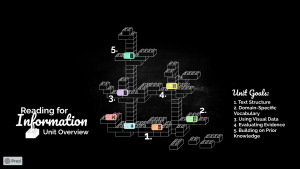31 Reading for Information Overview
Learning Objectives
-
Explore concepts about domain-specific reading skills (reading for information) that will be useful for the Science and Social Studies GED Exams.
-
Use metacognitive reading strategies before, during and after reading fiction, non-fiction and graphics.
Chapter & Discussion
This chapter includes a presentation that can be navigated in a classroom setting or independently. You can access the presentation via the link below.
Reading for Science & Social Studies: Unit Overview
Work through the different sections of the chapter and discuss ideas and topics as they arise. If you’re working independently, take notes instead. Notes and active discussion will be helpful in navigating this week’s assignments.
Overview
The GED breaks reading into two categories: Reading for Literature and Reading for Information.
Reading for literature is fiction and poetry.
Reading for Information is anything non-fiction. This includes articles, magazines, the news, speeches, essays, and textbooks. This is also the type of reading you’ll encounter on the GED Science and Social Studies tests.
In this unit, we’ll break down some strategies for tackling this type of reading and practice the skills that they’re looking for on the Science and Social Studies tests.
Domain-Specific Reading
Reading for Information is often domain-specific, which means that the reading is relevant to a specific field of study. There are a few strategies that can help us when dealing with domain-specific reading, such as:
- Building on prior knowledge
- Learning specialized vocabulary
- Using knowledge of text structures and genres to predict how to process the reading
- Mapping graphic representations against explanations in the text
- Posing discipline relevant questions
- Comparing claims and propositions across texts
- Using norms for reasoning within the discipline (i.e., what counts as evidence) to evaluate claims

Text Structure
Reading for Information usually has rigid formats for how to structure texts. We can use this to our advantage because these formats are designed to make things more clear. These include:
Headlines
Topic sentences
Intro, body, conclusion format
Nut graphs
Patterns for support paragraphs
Headings and tags
Learning these patterns in structure will help us to break down this type of writing quickly. It also helps us to find specific elements when we need to.
Domain-Specific Vocabulary
Reading for Information texts are almost always specific to a field of study. That means that they will include vocabulary from that domain.
We’ll study a few skills to deal with this.
First, we’ll practice vocabulary from the domains that matter most: science and social studies.
Next, we’ll practice some strategies for figuring out what these terms mean from the context. Usually, these writers try to explain these terms as they go.
We’ll also practice how to decode new fords from their Greek and Latin roots.
Using Visual Data
A major part of the science and social studies GED tests is to be able to interpret and analyze information from graphs, charts, maps, and other visual means. This is called visualized data.
We will do a few things to get more comfortable with this type of reading.
First, we’ll get associated with all of the types of visualized data that will be on the GED tests and practice pulling information from these to answer questions.
We will also practice making these types of graphic organizers so that you can get a feel for how they work from the inside out.

Evaluating Evidence
The science and social studies GED tests have a major emphasis on how to evaluate evidence. They want you to know how authors use evidence to prove their claims and ideas.
We will practice a few skills that will really help you to tackle this task.
We’ll dig into how to determine whether a claim is a fact or an opinion.
We’ll study the difference between primary and secondary sources and see how that impacts our understanding of information.
And, we’ll learn how to determine credibility and bias in a text.
Building on Prior Knowledge
The last thing that we’ll need to do is make sure that you have a strong foundation of the important concepts in science and social studies. This is important, because the GED assumes that you are already working with this prior knowledge.
We’ll do a refresher on the most important concepts in science and social studies, so that when you practice for these tests, you can build on that prior knowledge (which is one of the most important reading strategies.
We will cover everything that the GED assumes you know. And, I will make sure you have access to all of this information so that you can look over it as much as you need.
Assigned Reading
Here are this week’s readings. Additionally, please read for your own personal enjoyment for 1/2 hour each day. This will be called your “Reading Zone” reading and it will coincide with many upcoming activities.
Reading Strategies and Tips (via Oregon State University)
Problem Set: Practice Your Skills
Click here to complete a problem set that explores concepts from this chapter.
Completing problem sets like this can be an important element of independent study towards completing your HSE. I write these to resemble the style of questions you’ll find on the Reading and Language Arts GED.
Assignment: Vocabulary Pre-Test
Define the below terms to the best of your memory. If you don’t know one of them, take a guess, but make this answer bold in your document. Here are the terms:
Prior Knowledge
Graphic Organizer
Topic Sentence
Headline
Data Visualization
Primary Source
Secondary Source
Credibility
Bias
Scientific Method
Independent Variable
Fact Check
Assignment: Reading Zone Response (250 Words)
For Reading Zone, you must find a novel that is interesting to you and enjoyable to read. If you need help finding a Reading Zone book, please ask. Please read your Reading Zone book for a half-hour each day. On class days, there will be time in class dedicated to reading.
Create a two-paragraph response to the reading you did this week. The first paragraph should summarize what you read this week. The second paragraph should address the following prompt:
What is a novel? What is it about novels that you think audiences like? What are some things your author wants to express so far in this novel?


